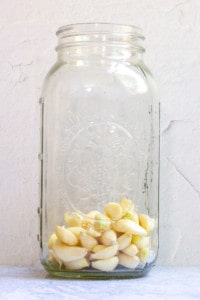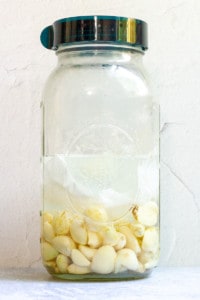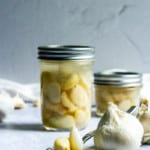Fermented Garlic
This easy fermented garlic is made with just two ingredients, whole garlic cloves and water. Lacto-fermented garlic can be used instead of raw garlic in your favorite recipes.
Servings: 20 people (2 clove servings)
Calories: 8kcal
Equipment
- Large Glass Jar (2 quarts recommended)
- Parchment paper
Ingredients
- 4 heads garlic Or as much garlic as you're willing to peel
- unchlorinated water
Instructions
- Peel all the garlic cloves. Break apart the head by pushing down on it with the side of a large chef's knife. Gently press on the cloves to loosen the peel, and then use your fingers to peel off the papery skin.Try not to break or crack the cloves. Ideally they'll all be intact. (If a few crack, it's okay.)

- Place the garlic cloves in a clean glass jar. I usually use a half gallon jar. Smaller jars are fine, depending on how much garlic you use. The jar should be big enough to allow plenty of head space above the garlic.

- Completely cover the garlic with unchlorinated water. The water should be an inch or two above the garlic, but there should still be a 2"-4" space in between the water and the top of the jar.Place parchment paper on top of the garlic to keep it from floating above the water.Use an airlock fermenting lid (to contain the smell). Alternatively, cover the jar with a paper towel or tea towel, and secure with a rubber band. Do not seal the jar with a lid (such as a canning lid). The garlic needs airflow.

- Store the jar out of direct sunlight for 2-3 weeks. Check on the garlic daily to make sure it's staying below the parchment paper. If any garlic pops up above the paper, push it down.After fermenting, move the garlic to smaller jars and top with the fermenting brine. Use within 6 months for the best flavor.

Notes
Yields approx. 40 fermented cloves if using 4 heads of garlic. Amount will change depending on how many heads of garlic are used.
Troubleshooting:
Blue or green garlic: This is caused by an enzyme reaction in the garlic. The garlic is safe to eat. This is more likely to happen with old garlic.
The fermenting problems below are usually caused by trying to ferment in temperatures that are too warm for the fermentation process. Try to keep your jars in a room that's between 55 and 75 degrees Fahrenheit.
Surface growth: If you see anything "scummy" starting to grow on your garlic while it's fermenting, scoop off the surface growth. If it smells fine, it is fine.
Over-Fermenting: If your garlic develops an awful smell (like rotting garbage), toss it out. If it smells a little funky, it's probably fine.
Mold Growth: If you're having problems with mold growing on the garlic or in the brine (not simply white scum on the top), toss out the garlic. Next time, make sure your garlic is fermenting in a room that's not above 75 degrees, and is in a place with good airflow.
Nutrition
Calories: 8kcal | Carbohydrates: 2g | Protein: 1g | Fat: 1g | Saturated Fat: 1g | Polyunsaturated Fat: 1g | Monounsaturated Fat: 1g | Sodium: 1mg | Potassium: 22mg | Fiber: 1g | Sugar: 1g | Vitamin A: 1IU | Vitamin C: 2mg | Calcium: 10mg | Iron: 1mg
